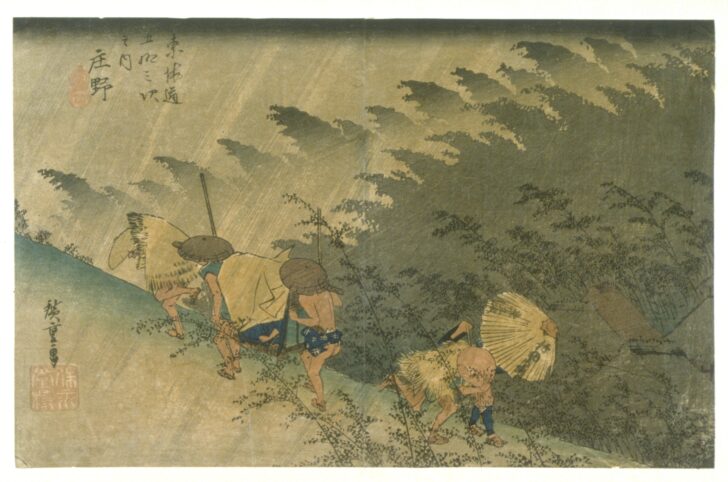Hôeidô Tôkaidô Series: Sudden Shower at Shôno
Utagawa Hiroshige

Description
Ando ̄ Hiroshige
Japan, 1797–1858
Ho ̄eido ̄ To ̄kaido ̄ Series: Sudden Shower at Sho ̄no Edo period (1615–1868)
1833–34
Color woodblock print on paper
Bequest of Margaret Watson Parker, 1948/1.130
Landscape prints began to appear in the Edo period
only in the early nineteenth century. The emergence of this new subject was the result of two things: a vogue for using the Western technique of one-point (or vanishing point) perspective to depict distant landscapes; and the increasing popularity of tourism along the highways that connect Edo (modern day Tokyo) with other major cities and pilgrimage sites.
The most heavily traveled highway in Japan was the To ̄kaido ̄ Road, which stretched between Edo and Kyoto. The fifty-three post stations along the road—areas where travelers could find lodging, food, and shops— were a frequent subject of Hiroshige’s prints. Here the artist captures travelers at the mercy of nature near
the station of Sho ̄no. By creating contrasts between dark and light colors and an abstract background and detailed foreground, and by using a dramatic diagonal composition, the artist makes a mundane scene into a human drama.
Subject Matter:
Shono is a 2.5 mile stretch of mountain path along the suzuka river. In legend, hero Yamato Takeru is fabled to have turned into a white swan somewhere along this stretch.
In this scene, the palaquin bearers scramble against the hill and torrential rain. Villagers bow their heads and straw hats and umbrellas into the wind to shield them from the sudden rain. Legs are raised upwards to show effort and speed as the people race to get out of the rain. Int he background the bamboo bend under the downpour, and the intensity of the rain gradually obscures them from our view.
--
The roaring success of the Hôeidô Tôkaidô series of woodblock prints firmly established Andô Hiroshige’s reputation as a master of his craft. Hiroshige had received attention for his previous publication of “Famous Places in the Eastern Capital,” but it was these 53 images along the Tokaidô Road that brought Hiroshige massive fame.
Travel guides and souvenirs from famous places and destinations were already on the market, and it was from some of these guides that Hiroshige often based his images. Some speculate that the mass appeal of the Hôeidô Tôkaidô series is due to the feeling, by viewing this images, that one is able to journey the famous road from Kyoto to the capital city of Edo without having to set foot on steep mountain paths or face inclement weather.
Inclement weather, however, is a phenomenon that Hiroshige excels at depicting. Here, caught in a sudden downpour, people rush along the steep hillside. Bamboo bends under the force of wind and rain, and the people in the foreground mimic this downward motion in order to shield their eyes from the water streaming upon them in torrents. Masterfully depicted, the viewer can almost feel the bullets of rain, and sense of sympathy for these unfortunate travelers.
Physical Description:
Here, caught in a sudden downpour, people rush along the steep hillside. Bamboo bends under the force of wind and rain, and the people in the foreground mimic this downward motion in order to shield their eyes from the water streaming upon them in torrents. Masterfully depicted, the viewer can almost feel the bullets of rain, and sense of sympathy for these unfortunate travelers.
Usage Rights:
If you are interested in using an image for a publication, please visit https://umma.umich.edu/request-image/ for more information and to fill out the online Image Rights and Reproductions Request Form.